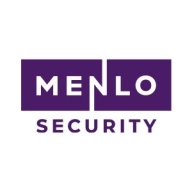


Cisco Secure Email and Menlo Protect compete in email security. Cisco Secure Email seems to have the upper hand with its comprehensive features and more budget-friendly pricing, while Menlo Protect's innovation in threat isolation justifies its higher cost for some organizations.
Features: Cisco Secure Email offers robust malware detection, spam filtering, and flexibility to adapt to diverse organizational needs. Menlo Protect provides browser isolation technology, cutting-edge threat isolation, and enhanced protection from web-based threats.
Ease of Deployment and Customer Service: Cisco Secure Email offers straightforward deployment with responsive customer service for smooth integration. Menlo Protect, with a slightly steeper learning curve due to its advanced features, offers dedicated support to assist the process.
Pricing and ROI: Cisco Secure Email provides a competitive pricing model promising significant ROI through cost-effective security measures. Menlo Protect, priced higher, provides substantial ROI through unique threat isolation capabilities, appealing to organizations focusing on advanced long-term protection.



Microsoft Defender for Office 365 is a comprehensive security solution designed to protect organizations against advanced threats in their email, collaboration, and productivity environments. It combines the power of Microsoft's threat intelligence, machine learning, and behavioral analytics to provide real-time protection against phishing, malware, ransomware, and other malicious attacks.
With Microsoft Defender for Office 365, organizations can safeguard their email communication by detecting and blocking malicious links, attachments, and unsafe email content. It employs advanced anti-phishing capabilities to identify and prevent sophisticated phishing attacks that attempt to steal sensitive information or compromise user credentials.
This solution also offers robust protection against malware and ransomware. It leverages machine learning algorithms to analyze email attachments and URLs in real-time, identifying and blocking malicious content before it reaches users' inboxes. Additionally, it provides advanced threat-hunting capabilities, allowing security teams to proactively investigate and respond to potential threats.
Microsoft Defender for Office 365 goes beyond email protection and extends its security features to other collaboration tools like SharePoint, OneDrive, and Teams. It scans files and documents stored in these platforms, ensuring that they are free from malware and other malicious content. It also provides visibility into user activities, helping organizations detect and mitigate insider threats.
Furthermore, this solution offers rich reporting and analytics capabilities, providing organizations with insights into their security posture and threat landscape. It enables security administrators to monitor and manage security incidents, track trends, and take proactive measures to enhance their overall security posture.
Cisco Secure Email ensures email traffic security, acting as a checkpoint before emails enter environments like Office 365. It filters out spam, phishing attempts, and malicious content, scanning emails for threats. It offers both inbound and outbound email security with features like URL filtering, spam filtering, and encryption.
Cisco Secure Email functions as an email gateway in cloud, on-premise, and hybrid deployments. Offering capabilities such as Advanced Malware Protection, URL and Reputation Filtering, and real-time threat intelligence from Talos, it efficiently safeguards email traffic. Detailed logging, reporting, and quarantine management features provide robust security while being highly configurable. Its integration with SecureX and customizable rules enhance its effectiveness. Though strong in malware protection, improvements in reporting, phishing detection, user-friendliness, and integration with Office 365 are areas of focus. Scalability, cost-effectiveness, and AI-driven features are also areas where it can advance.
What are the most important features of Cisco Secure Email?Cisco Secure Email integrates effectively in sectors like finance, healthcare, and education that need stringent data protection and compliance. Financial institutions favor it for its encryption and data leak protection features ensuring secure transactions. Healthcare organizations use it to adhere to compliance requirements like HIPAA, safeguarding patient data with advanced threat detection and email security. Educational institutions rely on it for protecting student data and intellectual property from phishing and malware attacks, ensuring a secure communication environment.
Menlo Secure Cloud Browser
The Menlo Secure Cloud Browser works with HEAT Shield and the Menlo Posture Manager to transform any browser into a secure enterprise browser. By fetching and processing web content within a cloud-native platform, it protects endpoints from internet-borne threats like phishing and evasive malware. AI-powered cloud content inspection, coupled with a wide range of protective features, enables administrators to enforce granular usage policies based on user, content, or website categories, ensuring a secure and risk-free browsing experience across the enterprise.
Menlo Security HEAT Shield
Menlo Security HEAT Shield detects and protects against highly evasive advanced malware threats and targeted zero-day phishing attacks. HEAT Shield puts AI-powered “eyes” on browser and dynamic web content, so users can focus on work, not threats. Working in tandem with Menlo Secure Cloud Browser, HEAT Shield provides an additional layer of security, enabling real-time threat detection and prevention. Through a combination of object detection, URL risk scoring, and correlated analysis of web page elements, HEAT Shield effectively identifies and neutralizes evasive threats, significantly reducing the exposure window compared to traditional security solutions. Menlo HEAT Shield can catch zero-day threats and brings modern protections to every single user, no matter where they work.
Remote Browser Isolation
Menlo Security Remote Browser Isolation provides a prevention-first approach, allowing users to work without worry by protecting them against targeted phishing and evasive malware threats. Menlo Security gives IT teams peace of mind without sacrificing speed for security and provides a seamless browsing experience for users, allowing them to work across any website, SaaS platform or private application. Menlo Security Remote Browser Isolation provides unmatched scalability for any size organization and fluctuating traffic loads for remote browsing sessions, applications, or digital documents. It doesn’t matter if you have 300 or 3 million users. Menlo scales across all users, entire organizations and all applications with zero impact to end user performance or the native browser experience.
We monitor all Email Security reviews to prevent fraudulent reviews and keep review quality high. We do not post reviews by company employees or direct competitors. We validate each review for authenticity via cross-reference with LinkedIn, and personal follow-up with the reviewer when necessary.